The Destroyer To The Rescue
Predatory Helpers
Some of the figs — the varieties Rabbi Samuel, Brown Turkey, and San Piero — started ripening last week. With their ripening, I am now in a position to claim victory over the mealybugs that have invaded my greenhouse fig-dom for the past few years.
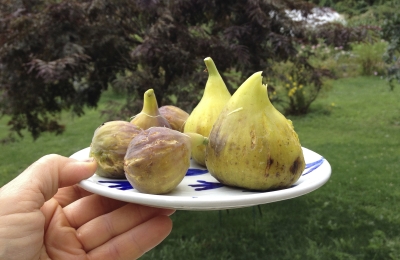 Mealybugs look, unassumingly, like tiny tufts of white cotton, but beneath their benign exteriors are hungry insect. They injects their needle-like probiscis into stems, fruits, and leaves, and suck life from the plants, or at least, weaken the plants and make the fruits hardly edible.
Mealybugs look, unassumingly, like tiny tufts of white cotton, but beneath their benign exteriors are hungry insect. They injects their needle-like probiscis into stems, fruits, and leaves, and suck life from the plants, or at least, weaken the plants and make the fruits hardly edible.
Over the years I’ve battled the mealybugs at close quarters. I’ve scrubbed down the dormant plants with a tooth brush dipped in alcohol (after the plants were pruned heavily for winter). I’ve tried repeated sprays with horticultural oil. I put sticky bands around the trunks to slow traffic of ants, which “farm” the mealybugs. And I’ve rubbed them to death with my fingers when I came across them on the stems. All to no avail. The mealybugs always made serious inroads into the harvest.
Mealybugs finally have been quelled this season thanks to another insect, the aptly named “mealybug destroyer” (Cryptolaemus montrouzieri), available from www.insectary.com. To soldier along with the mealybug destroyer, I also ordered some green lacewing (Chrysoperla rufilabris) eggs. Besides attacking the mealybugs, the lacewings prey on aphids, seizing the aphids in their large jaws, injecting a paralyzing venom into them, and then sucking out their body fluids. With good reason, lacewings are also called aphid lions.
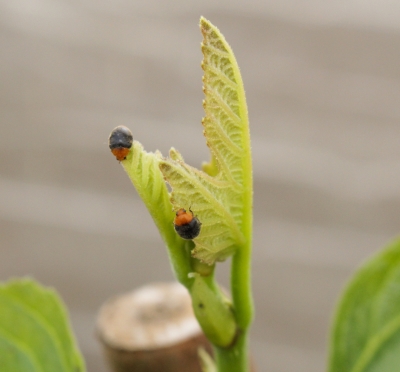
Mealybug destroyer
I ordered the first batch of predators in early summer. After recently noticing a buildup of mealybugs again, I ordered another batch. The mealybug destroyer and aphid lion populations may have plummeted after they ate all the bad guys, or they may have found their way to greener pastures via the many openings in the greenhouse.
The smallest amount of either pest that could be purchased could have policed a greenhouse much larger than mine, so the predators were relatively expensive: about $80 per shipment, with shipping. Still, I estimate the potential ripening of about 160 figs, which brings their cost to $1 per fig. Not bad for a dead ripe, juicy, ambrosial fruit that, with each bite, transports me back thousands of years to the Fertile Crescent, where figs originated.
Help From The Queen
A visitor to my greenhouse might have thought it looked weedy this summer. Tall flower stalks of Queen Anne’s lace grew with abandon, cilantro flowered and then their seed heads flopped down willy nilly, lettuce grew bitter as the plants bolted, and mustard greens shot up stalks capped with yellow flowers. There was reason for this wild wantonness.
The purpose of all these flowers was to encourage the adult mealybug destroyers and aphid lions to stick around. Flowers of plants in the Carrot Family, such as Queen Ann’s Lace and cilantro, the Daisy Family, such as lettuce, and the Mustard Family, such as, of course, mustard, provide nectar and pollen that the predators enjoy.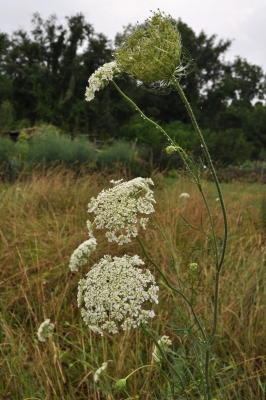 The Carrot Family Helps Out
The Carrot Family Helps Out
I also encouraged beneficial insects outdoors, in my vegetable gardens, by growing or, at least, letting grow, some of these same plants.
Add to that list dill, another member of the Carrot Family, which I always let flower and set seed in the garden. Those seeds become next year’s dill plants with no extra effort on my part except to weed out excess self-sown seedlings.
For some reason, dill did not self-seed in the garden the past two years, so this year I bought and planted seed. “Planted” might be too specialized a term for what I did. In fact, I just tore open the packet of seeds, poured them into my hand, and waved my hand as I let the seeds fly. Like magic, seeds sprouted a few weeks later.
This season’s dill not only encouraged beneficial insects and provided some ferny leaves and seed heads for flavoring, but also provided beauty. The variety was ‘Fernleaf,’ which grows dwarf, compact plants that also are slower to make flower heads. Perhaps it was the compactness of the flat heads of greenish yellow flowers or the denser backdrop of green leaves, but the plants captured my attention every time I walked by them. Still do, because they’re still blooming.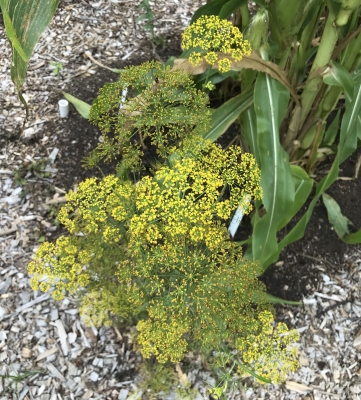
Queen Anne’s Lace also appeared in my garden with no extra effort on my part. Not only from self-seeding, as a weed. But also from an occasional rogue carrot seed from those I planted. Queen Anne’s Lace and carrot are the same genus and species, carrots having been selected and bred to make fatter, juicier, tastier, and orange-er (or, these days, purple-er) roots.
Here, at least, this season was particularly welcoming of QueenAnne’s Lace. The meadow next to the vegetable gardens has been dotted white with an abundance of their flowering heads.

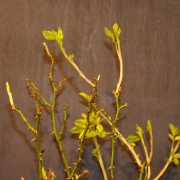


I love your combat methods! I had a dill forest one year in the garden and haven’t since let it grow with abandon but you’ve changed my mind. I will scatter some dill around next year!
Just don’t let it get too out of hand. Remember that “a weed is a plant in the wrong place.”
I am looking for some advice.
yellow jackets are attacking my ripe raspberries and figs. How can i fight them.
Thank you, Carla Zimmermann
Find and zap their nests with spray or torch. On the other hand, yellow jackets are beneficial insects. Then again, raspberries and figs really taste good.
I agree that figs and raspberries taste good. !!!
I dont know were the yellow jacket nest is and don’t want to find out by stepping in it.
But thank you for your answer.
CZ